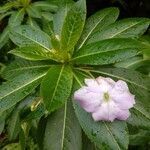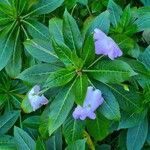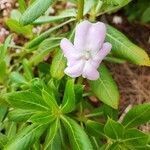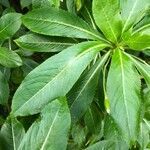Subshrub to c. 2 m high, suckering, bushy, glabrous. Stems few-branched, green above, red below, thick, ±succulent except at base. Leaves in whorls of up to 6; lamina oblong or oblong-obovate, 6–12 cm long, (1.5–) 2–3.5 cm wide, base attenuate or narrow-cuneate, margin prominently toothed, apex acute; petiole 0.5–2 (–3) cm long, broadly winged (so leaves often appearing sessile). Flowers solitary on slender pedicels amongst axils of uppermost leaves, 5–6.5 cm diam., usually pale pink, but varying from white to violet. Lateral sepals 10–11 mm long, ovate, acuminate; posterior sepal broadly ovate, convex and keeled when fresh, flat or nearly so when dry; spur 2–4.5 cm long; very slender. Corolla irregular, with face flattened; upper petal c. 2.5–3 cm long, 2.5–3 cm wide, deeply emarginate; each lateral petal united at base, having a lower obovate and an upper suborbicular segment, c. 2–2.5 cm long, 1.5–2.5 cm wide, slightly emarginate. Anthers rose. Fruit to c. 2.5 cm long, fusiform, distinctly 5-ribbed, c. 3 mm wide. Seed not seen.
Glabrous subshrub to c. 2 m high, bushy; stems green, ± succulent above. Lvs in whorls of up to 6. Petioles 0.5-2 cm long, winged. Lamina 6-12 × 2-3.5 cm, oblong or oblong-obovate, prominently glandular-ciliate; base attenuate or narrow-cuneate; apex acute. Fls solitary on slender pedicels amongst axils of uppermost lvs, 5-6.5 cm diam., pink. Lateral sepals 10-11 mm long, ovate, acuminate. Posterior sepal broadly ovate, convex and keeled when fresh, flat or nearly so when dry; spur 2-4.5 cm long; very slender. Corolla irregular, flattened and in 1 plane; upper petal c. 2.5-3 × 2.5-3 cm, deeply emarginate; each lateral petal united at base, having a lower obovate and an upper suborbicular segment, c. 2-2.5 × 1.5-2.5 cm, slightly emarginate. Anthers rose. Fr. to c. 2.5 cm long, fusiform. Seed not seen.





